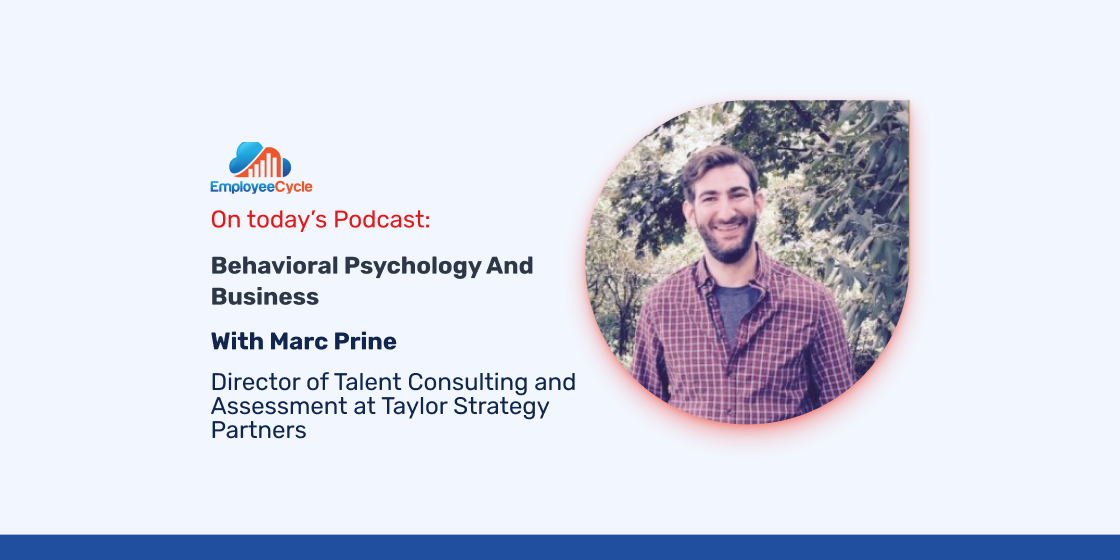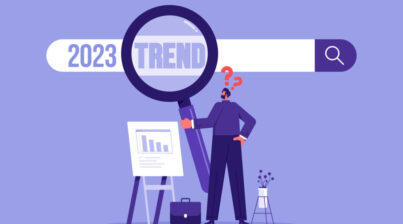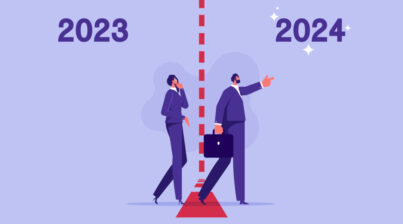Salas talks behavioral psychology and business with Marc Prine, Director of Talent Consulting and Assessment at Taylor Strategy Partners. TSP uses quantitative and qualitative assessments to help corporate clients find the best fit for their open positions. And Marc names the one behavioral psychology book that he re-reads every year!
Employee Cycle blog: https://www.employeecycle.com/blog/
Taylor Strategy Partners blog: http://taylor-strategy.com/blog
Transcript:
Salas: Hello and welcome to the Employee Cycle Podcast, I am your host Salas Saraiya, and on this podcast you can spec thought leaders and practioners in the field of people analytics, with an especially strong focus on the world of healthcare. From data scientists to HR professionals and consultants, our goal is to help you use data to create an amazing workforce. Now, on with the show! We are meeting today from Taylor Strategy Partners, this is Marc Prine, Marc has a PhD in business psychology from The Chicago School of Professional Psychology before joining Taylor Strategy Partners as the Director of Consulting and Assessment, welcome to the program Marc.
Prine: Hey thanks for having me.
Salas: How are you doing today?
Prine: All good, all good.
Salas: Tell me a little bit about what drew you into the field of psychology and how that ties into the world of business.
Prine: Yes sure, so it all starts back when I took an AP Psych class in high school, really getting to know about psychology, about helping people, is something that, just be able to see the direct effect of your work, was something that was really appealing to me, and then when I was an undergraduate I took an intro to industrial organization psychology class, IO psychology is business psychology, taking the psychological principles and implementing them in the workplace, which is what I do, and I’ll never forget the first day of class, the professor who is still a mentor of mine and I remind him all the time, said 40% of a person’s life is spent at work and by implementing these practices and these theories and, you know, theses empirical methods in the work place, you have the ability to impact 40% of a person’s life. We talk a lot, when talking to clients about the benefit of the organization, because yes, what I do helps to impact productivity, profitability, reduce turnover, increase all this metrics that people care about, but at the core of it, there is a person, and the ability to help somebody, to increase their job satisfaction or finding somebody who is a good fit for a role, which leads to higher employee engagement, and life satisfaction, and even their own in some respects, commission base jobs and their productivity.
Salas: Great, you are the Director of Consulting and Assessment correct? What is that consists of at Taylor Strategy Partners? And tell me a little bit about what Taylor Strategy Partners, what makes them unique in the field of human resources as well?
Prine: Yes, no, Taylor Strategy Partners, TSP as we call it, is a really unique organization in that where, what we call a 40 years old start up. The organization started in the late 60’s as your traditional executive search firm, helping clients place people in jobs; about 7 years ago they added resource, RPO team, which is Recruitment Process Outsourcing, which is really helping companies instead of the high level jobs that you usually send out for executive search, this is a lot of the regular field jobs, the sales people, the creative in advertising and things like that were really we can either take all or just a part of your recruiting and practice, and really outsource it to another group of people, and then about 4 years ago my team was started as kind of an Add-On to the search business, the VP of my practice Ted Thompson, works in doing executive assessments , really helping to identify who is the best person for the role and the leadership team at the Taylor Strategy Partners thought that this would be a great Add-On to the executive search business and will help you go find this person, and then when we find people we’ll also put them through this intense process and really make sure that they are the right person for you and for this role, and in the last 4 years we’ve grown this practice to being in projects where we work in tandem with our search and RPO team, but then also things that we do on our own to help clients in a number of ways.
Salas: That’s a great highlightable overview of what Taylor Strategy Partners is, can you take me through that process you were mentioning about the assessments, what is, what are all these assessments? What do they consist of and what do they add to the executive search process?
Prine: Yes, so the executive assessment process is really a deep dive into an individual, so when the search process starts, we meet with the client and help them identify what is ok, what is the perfect person look like for you, what is the perfect you know, what are the knowledge skills abilities really them build some of the intangibles, I’m sure you might need know that for a CFO you need somebody who is a CPA who has financial forecasting and all these other things, but then there is all this intangibles, what leadership skills do they need, how do they have to hold people accountable, what type of methods of persuasion in work; so those are the things we dig into and then what we’ll do, is put each candidate through a 3 step process; 1st we put them through either a personality cognitive ability, some kind of assessment that has been properly validated, it’s an online assessment that they take, usually takes 45min to an hour, nothing crazy, and what does that, is that it gives insight into what are their behavioral tendencies; in the perfect world how are they going to act, when they are under stress, those kind of things, from their wearable to do a little bit of a ride up and give the client some interview questions, some things that they might want to probe into during their interviews with them, and then when it comes down to the finalist we put them through a behavioral interview, which is something that is really us taking each one of the competencies that we identify during the competency modeling process, and really diving into them, really trying to find out, well, how are you collaborate decision maker, tell me about a time when really getting into the needy greedy about, taking dose behavioral tendencies and seen how will they executed them, and then the 3rd part which we usually do in tandem of that behavioral interview, is a role play, so what we’ll do is, we’ll put together based conversations with the clients and materials of here’s a common situation of somebody in this role can expect to see, let’s through them into this situation and let’s see what they do. Sure they can say that they exemplified these behavioral tendencies that we are looking for, but when they are put into a situation, how would they react? What’s their gut intuition? Sure it might be somebody who is really good at being a collaborative decision maker, but when you throw them into a situation where they feel a little bit uncomfortable, did they get directive? Did they get offensive? People look for those things, and let’s see what are the consistencies and what are the differences across the 3 different ways that we collect data.
Salas: Got you, and is the idea that every role makes offers slightly differ; different personality traits or are there good personality traits and bad personality traits, what are these assessment test trying to get at?
Prine: Yes, so it’s all about the role tendencies and things that are specific to the role, we do not use the same competency model or assessment for everybody, we actually purposely do not have any preparatory assessment because if our only tool is a hammer, then everything is going to look like a nail, but if we are able to take that step back and say ok, in this role this is what you need, then we can go and find and create the assessment materials that will help measure those things. A really good example is, we’ve actually done the same position and I’ve done assessments for the same position with 2 different competitors and the competency models couldn’t have been any more different, and it’s just because the environment which these people have been operating.
Salas: And how are they different?
Prine: So for an example, these where directors of a commercial, directors of sales for giving organizations in one instance they were going to be driving the teams and everything is going to be about making the other people successful and they have to do a lot more coaching, where in one situation they are out in the field and drumming up the business, they are really just being brought in as kind of the rainmaker; one person in one situation, they like to call to be in a relationships and they will trade a sale today for a bigger sale, and relationships down the road, where as the other one is more of the hunter mentality, let’s get this sale and move on to the next and is less about the relationship.
Salas: Great, so trying to get an idea of how this ties back into analytics, this sounds like partially, is this more quantitative or qualitative? First of all, I am just curious.
Prine: So, it’s a mix of both, the personality assessments that we use they are collected data that we bring in on a, it’s a validated standardized assessment where we get different people scores on different personalities and behavior trades in a quantitative measure and then what we’ll do is use that as a piece of the formula that we’ll put together; I’ll do a behavioral interview which is qualitative and then I’ll translate how they matched up compared to an intro, transfer that to quantitative numbers that I can put in together in equations on how somebody overall scored.
Salas: And are these assessments given to you by the company or are they things that you determine based on looking at who’s successful in the company?
Prine: We created them based on the research that we do at the beginning of the engagement. So the personality assessments, cognitive ability and those things, those are off the shelf once that we use, we like to use assessments like the Watson Glaser, The Wonderlic, occupational personality questionnaire, Hogan, developmental, all these different types of assessments that measure different things, we use them because we like to use previously standardize assessments, we can say “here is the validity measures”, “here is the reliability measures”, “here is exactly what we are measuring and how we are doing it”.
Salas: What are some of the different industries that you found these processes to be successful?
Prine: So I think that the beauty of the work is their industry agnostic, is really all about what the needs of the organization are and since every organization has people, and every organization operates a little bit differently, we do a lot of work in the healthcare, biotech, pharmaceuticals, sciences, whether there be hospitals systems and other things like that, we do things for large manufacturers, we do things for insurance and financial services or really, we really kind of operate all over the place because the skills and the principals are transferable across the industries.
Salas: Great, our audience is mostly healthcare organizations, that’s what we are focusing on right now, as Employees Cycle, so just to get an idea of how this process works in the healthcare arena, how does doing assessments on potential executive candidates drive the healthcare organizations forward?
Prine: Yes, we see a lot of the great results because it is such a regulated industry and there are so many things that those little differentiators, those are what going to make the difference between you and your competitor. I’ve done a lot of work actually with director of patient experience in hospital systems, and these are the people who know organizations and healthcare organizations are starting to focus so much more on the patient experience, that’s a much more important aspect of the hospital experience now, and of the healthcare experience because there is so many options on what’s going to be your heat differentiator and that patient experience, so really understanding well what are the construct on which this person is going to be able to be operating, what are the things that they need to display, how do you want this person to be the face of your organization when it comes to the patient and their families, and really tying together all the care that they are getting form the doctors and nurses and specialists, and making sure that they are getting that police of experience, and it’s really helping find those differentiators, the more competitive a market is, the more competitive the position is, the more competitive whatever the organization is looking to do, then the bigger, the more important that those little differences between one person and the next is; making a bad hire cost an organization a lot of money, a lot of time and a lot of reputation and those are the things that buy, I mean there is a lot of research and data that supports what I’m saying, and is that doing the proper betting process and putting people through this assessments and processes will lead to better decision making.
Salas: Yes sir, I think we’ve all seen the angry boss, like stereotyped at least once in action and it’s important to make sure that doesn’t happen, especially in the healthcare setting where it can impact lives, I think that’s…. Have you had experience like seeing that, maybe from a far, how is that like kind of, insight drive of the things you do.
Prine: Yes, I mean, we do, so one of my favorite projects that I worked on was actually doing some work where we were ask to come into an organization that had, a healthcare organization that had a high amount of turnover, and they said, “hey can you help us figure out why we have so high turnover, and fix it”, and we did and analysis, we collected a lot of quantity, we did both of quantitative research and qualitative research, understanding what are the different personalities types that we got going on, what are the key competencies and what are the key drivers for performance, we collected a lot of performance data to find pockets where people was more successful or less successful, and it was; a lot of the times it came back to, when 6 or 7 people that report to this person are underperforming then we move this 1 person to another team and they became a better performer, something is interesting there, we see some things there, and we found a lot of interesting things when doing the research and actually collecting as much data as we can and taking a step back, creating those regression formulas that we can say, “where can we predict performance?, what are the key drivers of performance in this situation?” and then making sure that we are saying, “ok, well, are they selecting the right people out of the gate? Are they managing people the wrong way? Are they setting expectations improperly? What’s happening?”
Salas: That sounded like a really interesting case where, it sounded like you, a person was underperforming in one department, you took them out of that department, you put them in a department that they were better suited for them and their performance improve, and you would have expect probably the performance in both of those departments may also improve, is that correct?
Prine: Yes, in that situation we actually didn’t do the change, we just notice that a few people they had dissertate, so people started at the beginning of the year where reporting up and one, to one manager and at the end of the year after they dissertate, they were reporting to somebody else, and we notice, that all the people who changed, there is some crazy things going on here, let’s understand that and we looked into, just the management style and what are the good managers doing vs. the bad managers, one of the big things, no matter what we are looking at is very important to remember, is that too many peoples will say, “what is average person doing, let’s measure against the average”, when in actuality we should be measuring against the exemplar, why are we not measuring as organizations? Why are we not measuring against out top performers? We are measuring against average performers and really trying to see what is this person doing that’s making them leaps and bounds ahead of everybody else, let’s find out what that is and let’s see how can we replicate that everywhere else throughout the organization?
Salas: Awesome, so what you are really trying to do is to help that organization and excel through finding out what their best performance are doing.
Prine: Exactly, and a lot of the times is really simple things, it’s those that person who when they are making a sales call they follow up with an email and say, “hey let’s recap what we talked about and this is what you said you’d do for me”, these are the people who do better planning ahead of time and these are people who set better expectations with their employees, is all these little things; the differentiators in terms of behavior are so small, but when it comes to the results they can be enormous.
Salas: Awesome, so do the little things, that’s the advice to tell those ones out there.
Prine: Do the little things, I mean, see what’s working and keep doing them.
Salas: Awesome, so let’s take a bit of a step back from your current position at Taylor Strategy Partners and I’m curious about your time at the Chicago school.
Prine: Yes, so I work as adjunct faculty, teaching master level statistics, it’s something that I enjoy doing, it’s fun, it’s a good way to really stay involved and keep sharp, keep thinking that way, it’s a different mindset.
Salas: Ok, the field that you mentioned was IO psychology, that’s actually the first time that I heard that term, what is it stands for?
Prine: Industrial Organizational Psychology, IO Psychology and business psychology is really just what that one program calls their eyes of Kant’s Psychology Department, it really goes a little bit all over the place, some places their IO Psychology is under organizational behavior, sometimes it’s management sciences, it’s all over the place, there is no good name for it, but IO Psychology, really touches on the entire employee life cycle, it’s…
Salas: We like that, employee life cycle.
Prine: Employee life cycle, yes, it’s ok, well you got a business strategy well, what is your people strategy to operationalize that business strategy? How are you going to measure it? What are those metrics that you care about? What are you looking for? How are you going to recruit people? How are you going to select people? Once you select people, what are you going to do that talent management, that learning in development, that performing management? All of those things, the retention, the burnout, all is really, it’s kind of human resources from a more strategic, is a lot of human resources from practices, but in a more strategic and scientific way; one thing that I like to harp on is that, we are still psychologist that are bound by the APA, American Psychological Association code of ethics, so there is nothing that I’m doing on the work place that I’m not able to find research and say, “this is why I’m doing it, there is empirical evidence saying that this is the best way to move forward”, it’s really how can you take people and make them the most effective and happiest, and really use; how many times do you watch a company CEO on stage and say “our people are the greatest resources, they are our greatest assets and are the most important thing that we have”? And what we are doing in what IO psychology and what we at TSP is really show executives, show clients, how can you make that true?, how can you really treat people like your greatest assets? And not only getting most out of them but also them to get the most of out of it as well.
Salas: Great, and what are some of the different ways that you apply in your practice, apply statistics to the employee cycle, day job process.
Prine: Yes, I mean we do atone with helping predict performance, that’s the goal, so we take a step back and we will look at year performance, annual performance, hear the people that are doing it, trying to find what are those differentiators whether activities that they are doing, whether is hiring profile they had when they were selected, whether there is all this different things and how can we map and help create, and see those differences that differentiate their top performer from everybody else?
Salas: Awesome, so meeting that prediction piece.
Prine: Yes, predictive analytics is a big hot topic right now, and a lot of businesses are doing it, when it comes to technology, big data is everywhere and this is really just getting HR seat at that table, and being part of that big data conversation, because there is so much data that’s collected in the HR, and so many people just don’t know how to use it; I think that probably one of the biggest aspects of my role is making statistics not scary, is showing people, “hey we can take this numbers and you don’t have to look at the numbers, I’ll look at the numbers for you, but let me help you take the story, let me help tell what are the important pieces behind it”, we work with a client, we develop a selection system, and it showed that they used to, in their old way of doing things, they were selecting people who just had the most amount of experience, they ended up, when every candidate resume looks the same, they end up just, “I’ll just take the person who has the most number of years of experience”, what does that mean? They end up having bad habits, because they’ve been around, and they’ve met so many different ways of doing things, they are usually the most expensive person, so right of the bat you have to pay somebody more money, and who knows if they are going to be a good fit for the culture; well what we did, was we created an assessment process for them, so all their candidates would go through this process and then they will be able to kind of jump off the paper, one of the things we talk about at TSP a lot, is that people are 3 dimensional, they are not just 2 dimensional resume that you have in front of them, but there are this other aspects, that are important for what they are, and what they can do, and we would like to create an assessment process that will help people stand out, and it’s really not surprising but the cream always rises to the top. So by collecting these data pieces and helping managers make decisions based on competencies and not just a job description, what we found was they were selecting people that didn’t necessarily had the most number of years of experience anymore, so they were people who were a little hungrier and earlier on in their career, they were cheaper so right of the bat the organization was saving money, and then what we found after a year, we collected all this data and we saw, Wow! The people that we selected ended up being better performers and in some regards just as good performers as the top people who had so much more experience, so the organization is being more profitable and then also they are making more money, their revenue is higher, but then they are also making more money because these people aren’t being paid as much, and because they are making smarter selection decisions.
Salas: That’s great, so they were selecting from the essentially the worst star alike, because they were selecting for the most expensive person, with most experience who may or may not work, and not selecting for the most potential to work out in that particular position, that’s good.
Prine: Yes, and of course, they are not, all the assessments that we use, and all the things that we are doing are properly validated, they are following all of the EEO compliances, type rules, so it’s not like we are telling them to not select the person who is the best selection, just based on competencies and not just looking at a resume.
Salas: Got it, so we’ve talk a lot about assessment, I am curious about how statistics, you use statistics to, maybe not you, but in particular, probably within your PhD program or you see it Taylor Strategy Partners held, statistics hasten to the recruitment and retention pieces.
Prine: Yes, so when it comes to retention is a lot of that, upfront research, it’s gathering all the data that we can and seeing what are the trends, and what are the things that the people who left haven’t comment, what are the trends and the things that the people who are still here in top performers, what do they have in common, really trying to take as much data as we can and see, it kind of really set through and see well, what are the themes? What are we looking for? What are the things that are maybe wrong here? And once that we find a few data points then we are able to go out and do interviews and focus groups, and kid of the qualitative side of things, and find out what is the story, let’s put more around this, “everybody on the west coast seems to be doing wrong? What is the west coast doing different than the west coast? Well let’s get a group of people and let’s find out”, and that’s really how we are using statistics and trying to, on the front end use the data, analyze it in a way that we can show, do we have enough big sample size? Yes; once we do, well let’s see what kind of decisions can we make? What kind of hypothesis can we run through? And really see what we are finding from a regression, from a correlation, and even something as simple as, T task and annuls.
Salas: Got it, and then on the recruitment side?
Prine: So on the recruitment side, statistics really doesn’t come into play as much, but they can say what we are really doing as helping them to put together a profile, what is this person look for? What should we be looking for, when we are going out and finding it? We did really interesting project with a large retailer and with that large retailer what we found was that they type of person that they were looking for had a very similar profile as a different profession, so we thought, “Have you ever thought about marketing? Hey we have an open job in specific linking groups and different things like that that are similar to the profession you are looking for”, and what’s actually great is the government has this website call ONET, I believe is through the department of labor, I’m not too sure, but what it does, is you can actually search jobs and it gives you in those typical jobs what are the knowledge skills abilities, activities, those kind of things that you’ll find in those jobs, so in those occupations, so what we can then do is look based on competencies and knowledge skill abilities for what other jobs are similar, in that way we’ll be able to kind of widen that net of recruiting, like “hey you’ve been doing this for a long time, but have you ever thought about something else, because it seems that you have a really good skills set for it.”
Salas: Awesome, so I think what we are trying to do is barely, early podcasts is just kind of highlight the staple of experts that we have, so thanks so much for being on the podcast today, that is very appreciated and I’m going to jump to lighting questions.
Prine: Oh no.
Salas: So these are not necessarily related to anything we’ve talk about, just be creative with them, as creative, they can tie into earlier stuff we talk about early, but they don’t have to though, just be creative with them; So the first one is what is the book you find yourself recommending to your friends more frequently?
Prine: That would defiantly be Dale Carnegie, How to Win Friends and Influence People? either that or Adam Grants, Give and Take, their 2 books and what is interesting about Carnegie, is that was written in the 30’s and I think just last year a group of psychologist went through and test it it’s theories and said “yes they still hold up empirically, and is just being nice to people and building relationships, and really trying to be or create a network and help others.
Salas: Nice, I know that book, it stills holds up after all this years, they have a lot of practical implementations that you can do there.
Prine: Very much, I actually do rear it every year, I make sure to refresh myself every year and read the book.
Salas: Nice, so the 2nd one is what’s the one thing that should be taught at school that isn’t already?
Prine: I mean, I have to say it’s just simple financial acumen, somebody who, I went to college and grad school and all these things; I never took a business class, so things like bouncing a checkbook, basic stock market tips, what to look for when you are applying from mortgage, those kind of things, I think are really important, and I wish I would have learn, outside of being a 22 year old and goggling, “hey, what’s this 401 (K) things I should be doing?”.
Salas: Yes, I agree a 100% on that one, because the economy is changing, people are more likely to be switching jobs, or starting their own entrepreneurial adventures, so it’s important, you are not just getting your W9 and then like cashing any more of your, you need to have that financial acumen, so I am with you on that one; and number 3, if you could go back in time, what year would you travel to?
Prine: Oh, that’s a good one, Boardwalk Empire got me really into the prohibition area, I think that stuff is really interesting, I’ve always been a student of the 60’s, I think that’s a really interesting time frame with –33:16 minuricious– orbs, sociopolitical environment change so much in the 60’s, women in the work place, and just changing landscaping in terms of conservatism, and people being more casual and I think that’s a really interesting time frame, so I’m going to pick 1961, because I’m a Yankees fan, and Roger Maris hit 61 homeruns that year.
Salas: Nice, so Marc thanks so much and where can people find you online?
Prine: Yes so you can go ahead and check us out at taylorstrategy.com, is our website, I am available on Linkedin, Facebook, Twitter, Instagram, we have a very active blog that we post a lot of really interesting things both about the recruitment side, and assessment and consulting side of business, as well as a lot of random things about our own corporate culture, what kind of things we like to do, some of the big nonprofits that we are available and that we are involved in as well.
Salas: Great, thanks Marc for being on the Employee Cycle Podcast and we may have you again on the feature to talk about more in depth about it, and many of the things we talk about today, so look forward to that.
Prine: Perfect, it was fun, thanks.
Salas: Alright.
About the host: Salas Saraiya is co-founder of the HR dashboard Employee Cycle.












